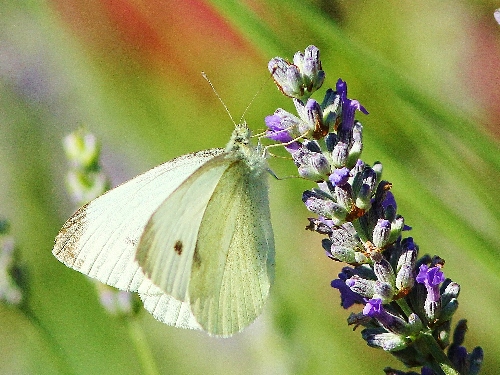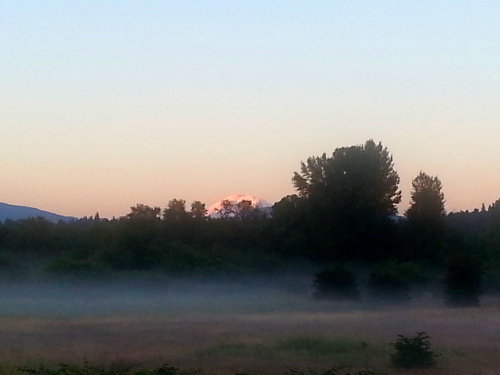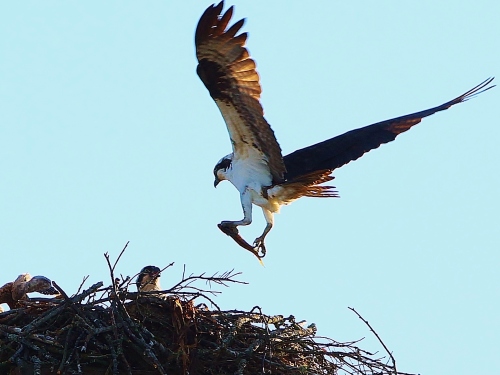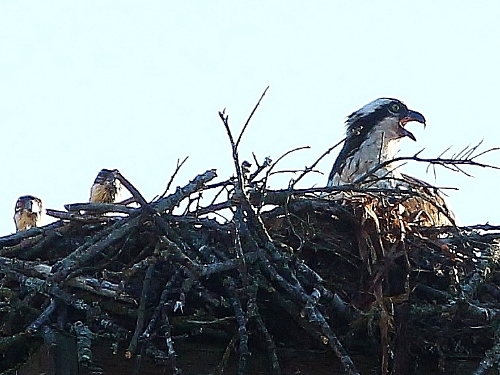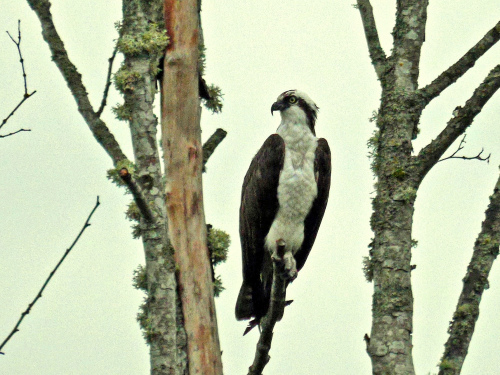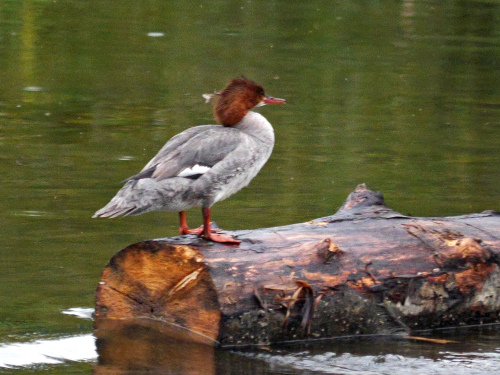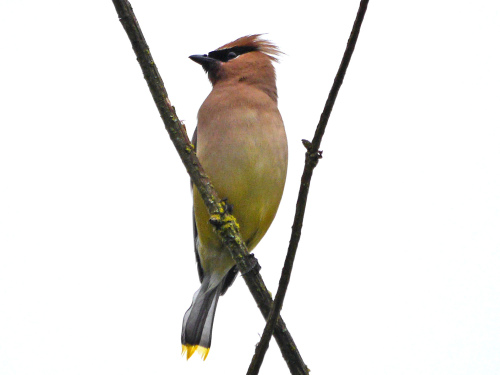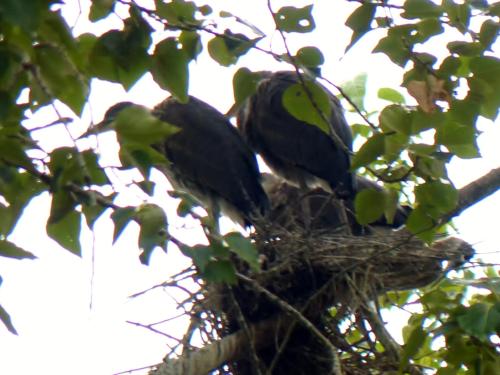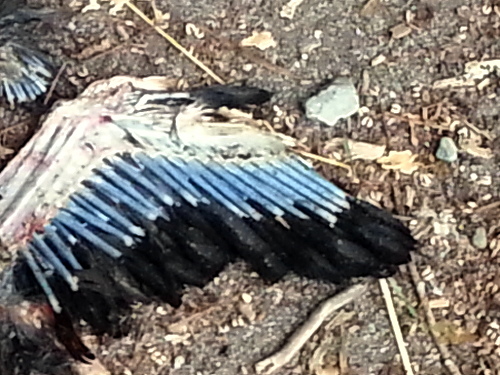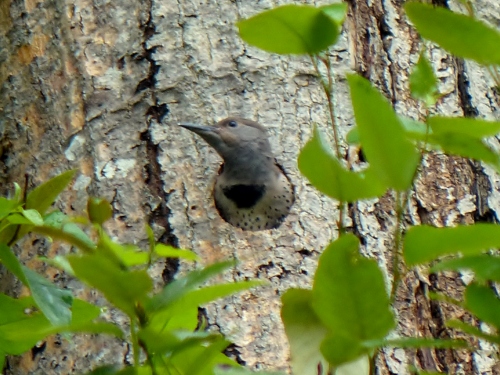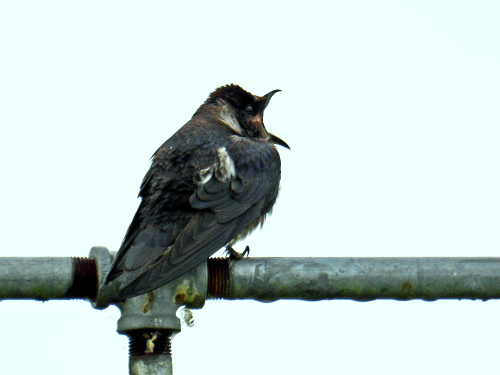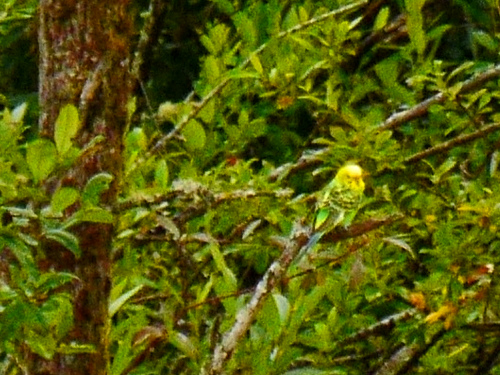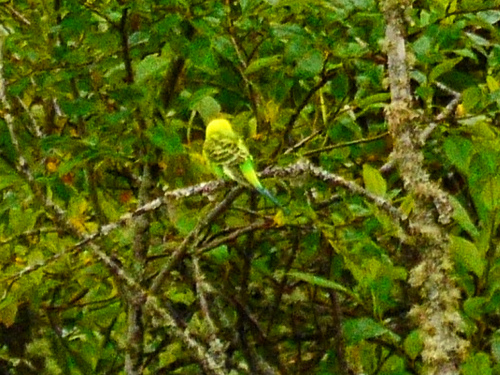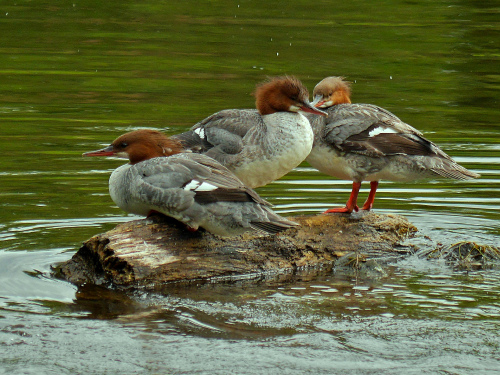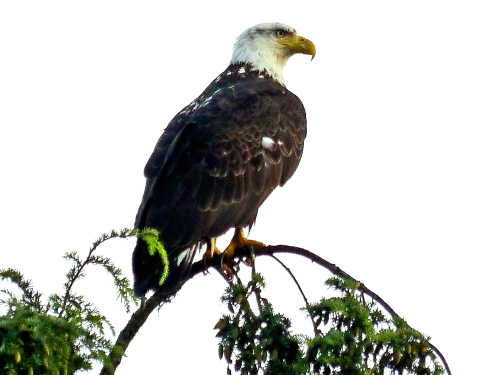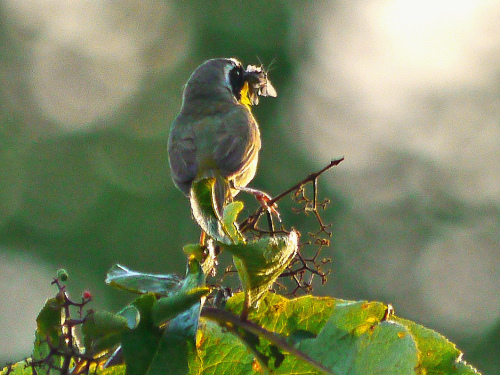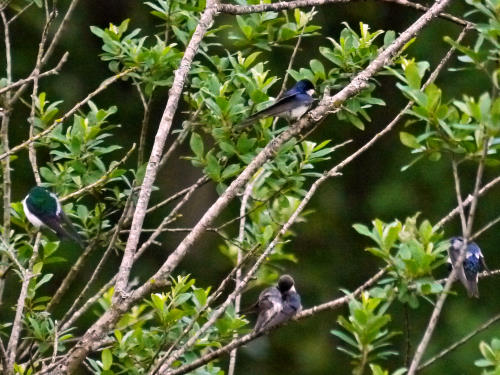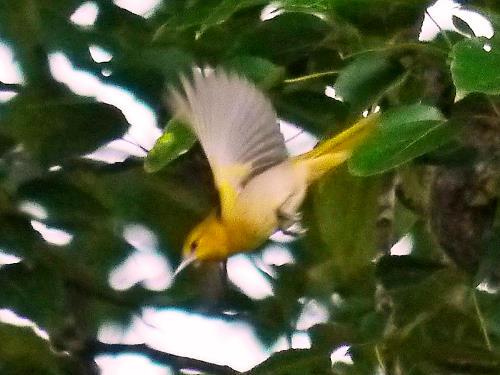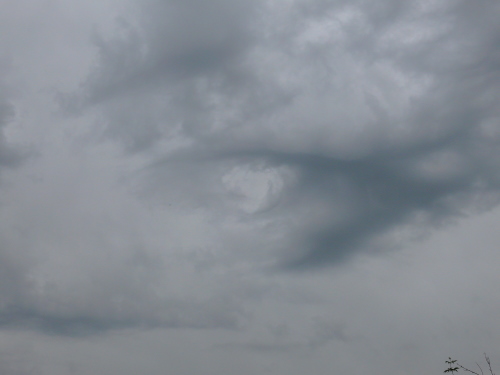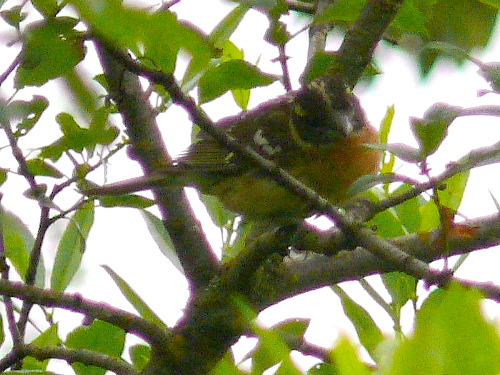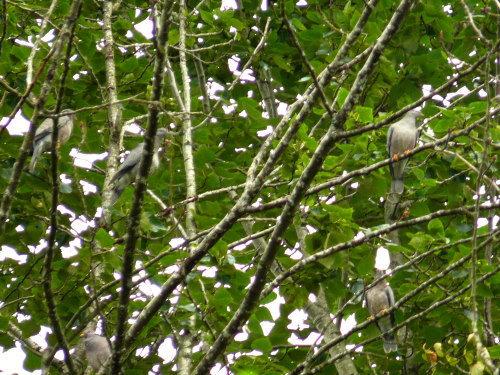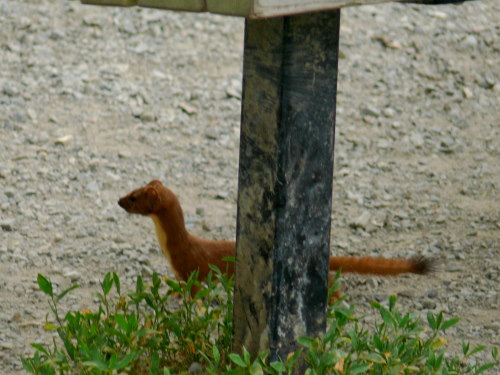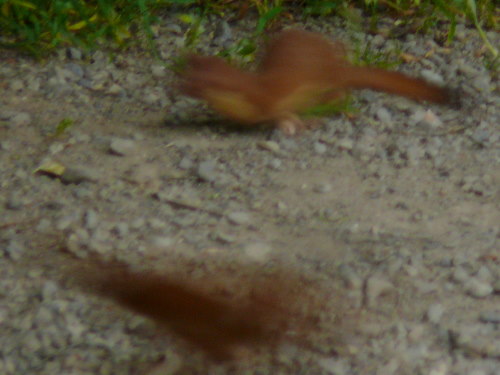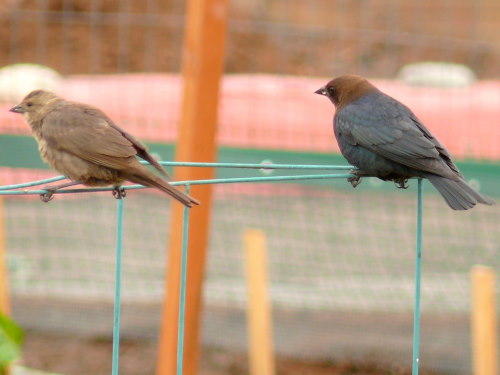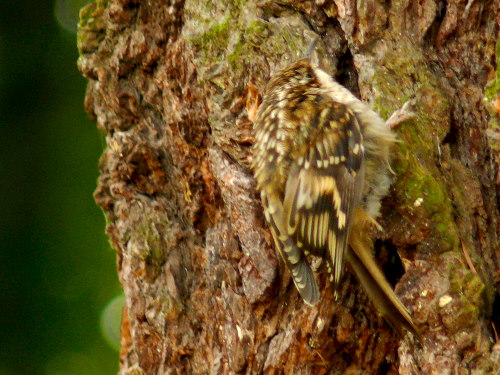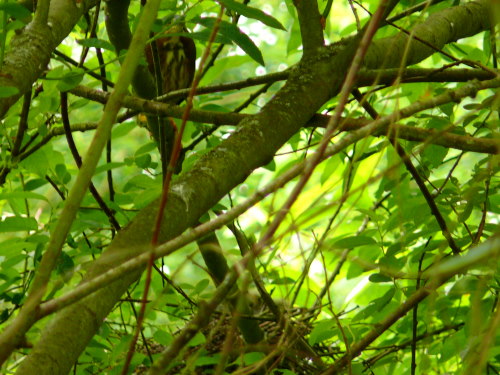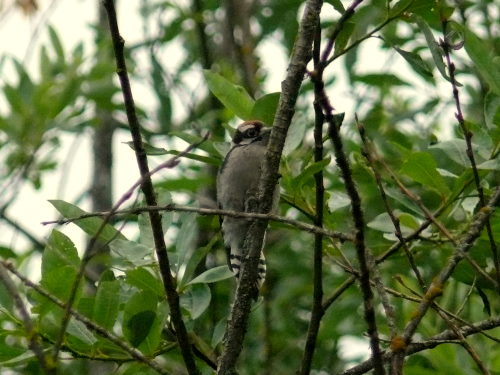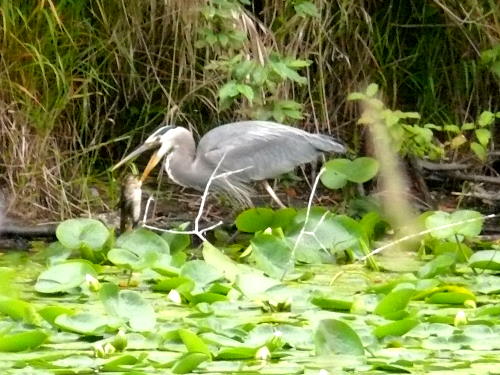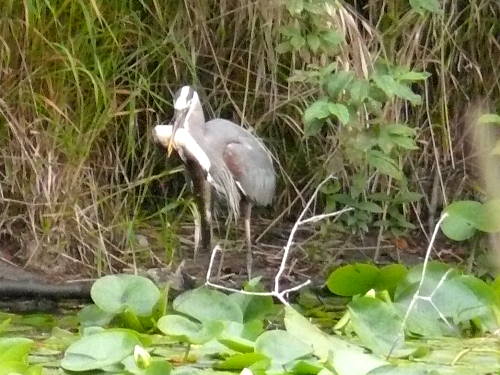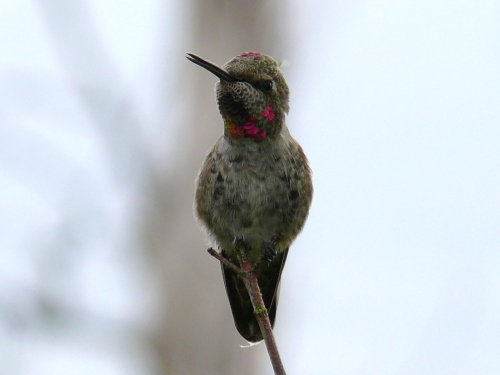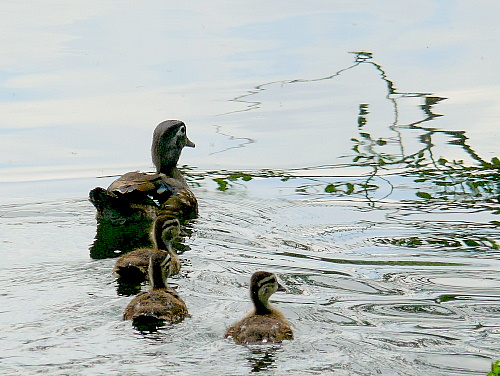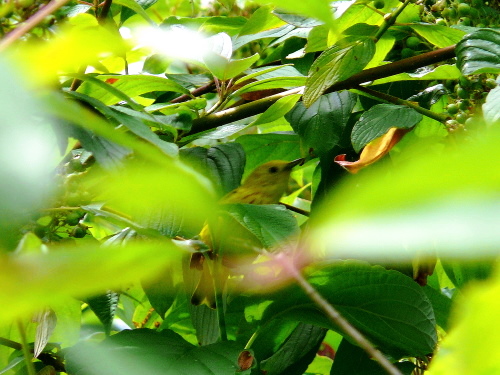Prev |
Bird Sightings Week 26
|
Next |
Rarities for Week 26:
| African Collared-Dove | 26-Jun-06 | Presumed escapee. Marc Hoffman and Ned McGarry, ph. |
| Northern House Wren | 10-Jun-21 | Bird remained 03-Jun to at least 01-Jul |
| Yellow-breasted Chat |
27-Jun-24 | Continuing from 13-Jun |
| American Redstart |
27-Jun-29 | Just south of Dog Area along slough trail. Nice bright adult male. Seen again 28-Jun-19 |
| ...Indigo Bunting |
18-Jun-20 | Singing male, Dog Meadow. Remained 11-Jun to at least 16-Jul |
| Budgerigar (escapee) | 26-June-14 | Seen from Lake Platform |
Report for June 26, 2025 Birding at Marymoor
| A morning with a solid overcast, but no precipitation and seldom any wind. Late June often starts the "doldrums" that usually continue through July. These are characterized by a paucity of surprises, coupled with the tailing off of bird songs and the departure of some of our breeding birds; it can sometimes get quite dull. But apparently that hasn't started yet. Today had several unexpected species, and we still had songs from pretty much all of the expected birds. Highlights:
The heronry is substantially emptier. The dead tree that has several nests had just 5 juveniles on nests today, where we had 20 two weeks ago. At the weir, however, in a very small area we found at least 15 juveniles standing in the water, waiting for fish to jump into their mouths. Another juvenile was low in a cottonwood, looking up, since up is where fish have always appeared... For the day, 58 species. Adding MODO and Caspian Tern, I believe we're at 121 species for the year. As an aside, Eastside Audubon has put out a video highlighting the Marymoor Bird Loop. I was interviewed for the video, and it's very obvious from my appearance that the interview was filmed at 5:30 a.m., with me having rushed over early before last week's survey. See https://www.youtube.com/watch?v=Z-hdUIf8GLk&ab_channel=EastsideAudubonSociety = Michael Hobbs |
|
|
|
|
Report for June 27, 2024 Birding at Marymoor
| We are officially in The Summer Doldrums. Combine that with the worst weather of the week, and it's no surprise we didn't see much today. It was dark all morning, with mist that progressed through mizzle, drizzle, light rain, and finally to just plain rain, before sequentially letting up. Highlights:
The chat was silent and unseen when we came through the East Meadow in the rain. When I say The Summer Doldrums, I refer to the seven weeks in a row (starting this week) where we've had fewer than 110 species for each of those weeks, cumulatively over the years of the survey. The third week in July (Week 29) is the low point, with only 99 species. Not only do we have few species during each of those seven weeks, we mostly just see the same 50-60 species week after week. We can get a smattering of shorebirds in July and early August, and a few unexpected flycatchers, plus we get to see a lot of baby and "teenage" birds doing cute and/or goofy things, but surprises are scarce and rarities are rare. The other time we have fewer than 110 cumulative species each week is December through the middle of March, but none of those weeks are as low as Week 29. The highest cumulative total for any week is 153 species reported during the first week of May (Week 18). Misses today, in the rain, included Hooded and Common Merganser, Pied-billed Grebe, Green Heron, Red-breasted Sapsucker, Cliff Swallow, Bullock's Oriole, and Yellow-rumped Warbler. For the day, just 52 species, with nothing new for the year. = Michael Hobbs |
|
|
|
|
|
|
|
|
|
|
Report for June 29, 2023 Birding at Marymoor
| It was a nice a day as possible at Marymoor today: temps in the 60's - 70's, clear blue sky, hint of breeze. Breeding season is wrapping up, and we saw the first signs of post-breeding dispersal; we saw a few species that don't actually breed in the park. Total number of birds was actually not that high, possibly since some of our breeders are off on their own post-breeding dispersal. Highlights:
Even with those misses, we had 58 species today plus "dark wing-tipped gull". We also had beaver and a deer. = Michael Hobbs |
Report for June 30, 2022 Birding at Marymoor
| It was a touch foggy and chilly to start the morning. Partly cloudy skies for most of the morning kept the temperatures moderate. The birds were very numerous and active, with many family groups making lots of noise. We got most of the species we'd expect for this time of year, and a few more species of birds and mammals to make it a very enjoyable day.
Highlights:
We also had Eastern Gray Squirrel, American Beaver out in daylight, Eastern Cottontail, and four River Otters in the slough
Misses today included Canada Goose, Hooded Merganser, Pied-billed Grebe, Green Heron, Belted Kingfisher, Golden-crowned Kinglet, Red-breasted Nuthatch, and Yellow-rumped Warbler.
For the day, 60 species of birds.
= Michael Hobbs
|
Report for July 1, 2021 Birding at Marymoor
|
Kind of a quiet, lazy morning at Marymoor today. Very comfortable, with overcast and temps in the high 60’s all morning. Many birds are still singing, but they are not perched out as obviously as early in Spring. Hugh numbers of juvenile birds, most drab and streaky. A few surprises.
Highlights:
Good day for animal sightings too, including three RIVER OTTERS just above the weir, two “Black-tailed” MULE DEER on far side off slough below the weir, and pre-dawn AMERICAN BEAVER and BAT sp. for Matt, as well as the usual EASTERN COTTONTAIL and EASTERN GRAY SQUIRREL.
Misses today included Canada Goose, Hooded Merganser, Pied-billed Grebe, Killdeer, Green Heron, and Cliff Swallow
For the day, 59 species.
== Michael Hobbs
|
Report for June 25, 2020 Birding at Marymoor
|
We had a very nice morning for our walk today. As usual for this time of year, not many surprises, except for a few seasonally unusual birds. But all in all, a pretty good day.
Highlights:
Below the weir, a COYOTE on the far shore caused the Mallards to sound like a synchronized chorus of bullfrogs. They were definitely concerned.
At the Rowing Club, a TOWNSEND’S MOLE tried desperately to burrow into the edge of the gravel path as we approached. It refused an attempt to guide it to softer ground.
And we had at least a dozen EUROPEAN COTTONTAIL.
For the day, 64 species of bird.
== Michael Hobbs |
|
Report for June 27, 2019 Birding at Marymoor
|
This week, Week 26, is the heart of “The Doldrums”, where just about every bird we see is a local breeder, and where we can predict with very high accuracy the exact list of species we’ll see. Barely worth doing the walk, one might say. Week 26, with just a cumulative 94 species, has the worst diversity of any week of the year. Or *had* the worst. Today was a special exception. The weather was definitely not propitious, with dark gray clouds and several brief morning showers. So much for predictions. Our best bird was an AMERICAN REDSTART, but that was by no means the only unusual sighting.
Highlights:
Misses today included Canada Goose, Pied-billed Grebe, Rock Pigeon, Green Heron, Red-tailed Hawk, Belted Kingfisher, Cliff Swallow, and Lazuli Bunting. For the day, 61 species.
Week 26 picked up three species (WEKI, EVGR, AMRE) bringing it to 97 species, one more than Week 4. And the AMERICAN REDSTART was a year bird. A pretty special day.
== Michael Hobbs
== Michael Hobbs |
|
Report for June 28, 2018 Birding at Marymoor
| A nice, if mostly cloudy day today. Lots of baby birds, but still many males singing.
Highlights:
The VIRGINIA RAILS were the big highlight. We haven’t even heard a rail since April, but today we heard what Matt thought were rail noises from across the river a little south of the Dog Meadow. About a minute after I played the call and got a response, Karen noticed an adult rail on mud across the river. As we watched over the next few minutes we spotted one, two, and then three black puffball babies following the adult around. Dare I say “cute”? Earlier, we were happy to find TREE SWALLOWS feeding a baby in a hole in a cottonwood snag. Many pairs nest in boxes and gourds each year, but seeing them nest in natural holes is quite uncommon at Marymoor. Immature birds noted today included DOWNY WOODPECKER, MARSH WREN, SPOTTED TOWHEE, COMMON YELLOWTHROAT, and BLACK-HEADED GROSBEAK, and at least 16 additional species. For the day, 63 species. Last Thursday evening, my wife and I heard a COMMON NIGHTHAWK, new for 2018. I believe that brings the park year list to 141 species. == Michael Hobbs |
|
|
|
|
|
|
|
|
|
|
|
|
|
|
|
|
Report for June 29, 2017 Birding at Marymoor
| Today should have been amazing, and it wasn’t. First warm day of the year, though we were underneath thick fog for most of the morning. Things didn’t liven up when the fog burned off though. It was just QUIET.
Highlights:
We did have a LONG-TAILED WEASEL that gave us a few glimpses. Today, not amazing, with 58 species, and low counts for many birds. Two new species for the year. I believe we’re up to 127 species for 2017. == Michael Hobbs |
|
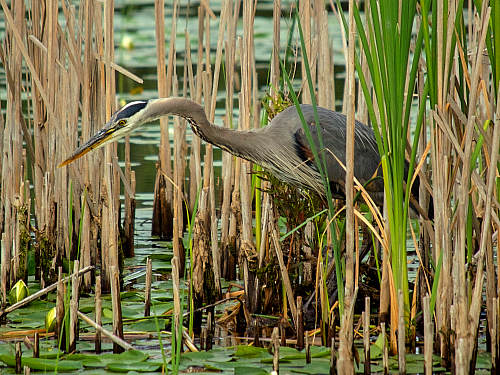 Adult Great Blue Heron. Note plumes at base of throat and on back, black-and-white crown, black streaks on upper neck, chestnut-and-black shoulders, pink/purple tinge to neck. Photo by Joanne Iskierka |
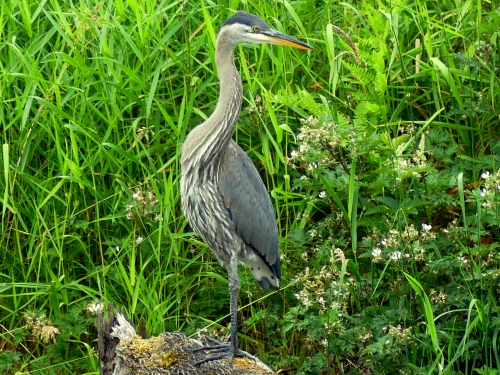 Juvenile Great Blue Heron. Note overall uniform pale gray color, gray streaks on throat and belly, dark gray (not black) on crown. Photo by Hugh Jennings |
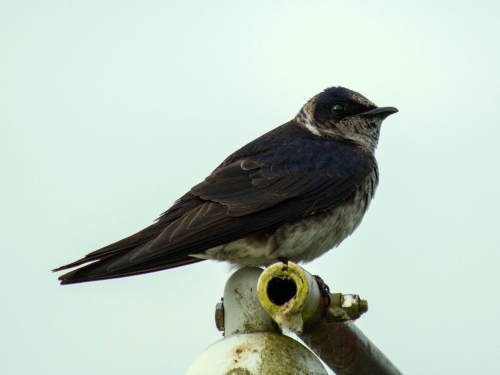 Purple Martin at the gourds. Photo by Joanne Iskierka |
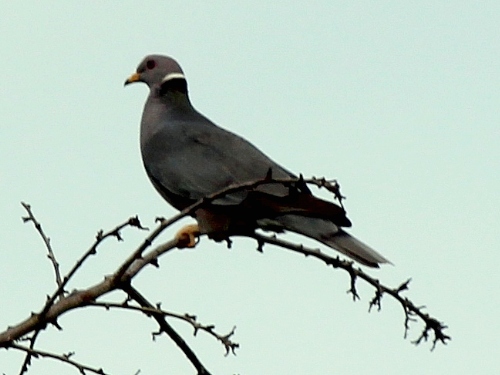 Band-tailed Pigeon. Photo by Milt Vine |
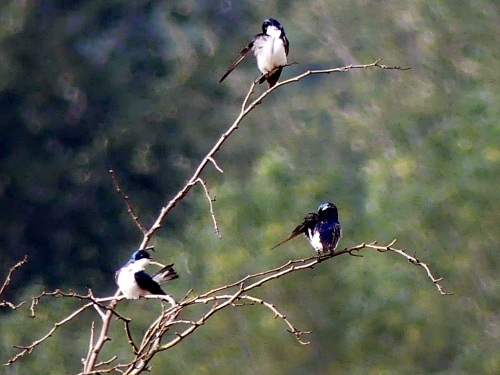 Preening Tree Swallows. Photo by Hugh Jennings |
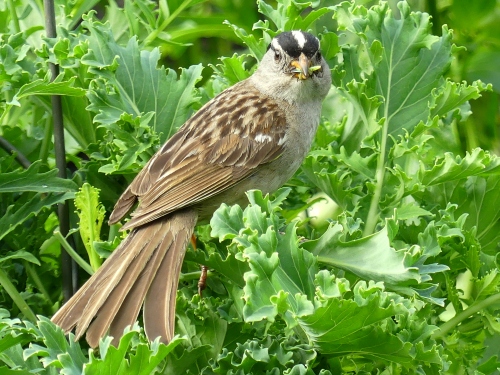 Adult White-crowned Sparrow in the Pea Patch. Photo by Joanne Iskierka |
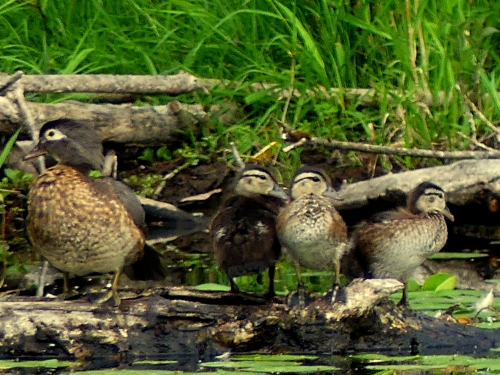 Wood Ducks at Rowing Club. Photo by Hugh Jennings |
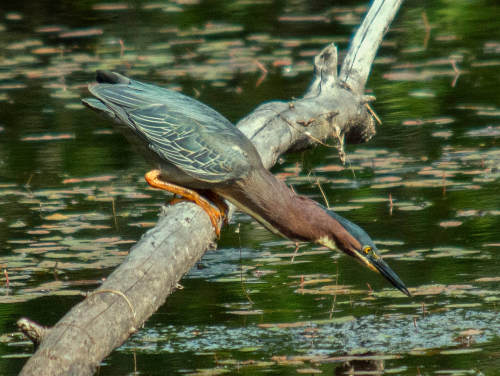 Adult Green Heron at Rowing Club. Photo by Joanne Iskierka |
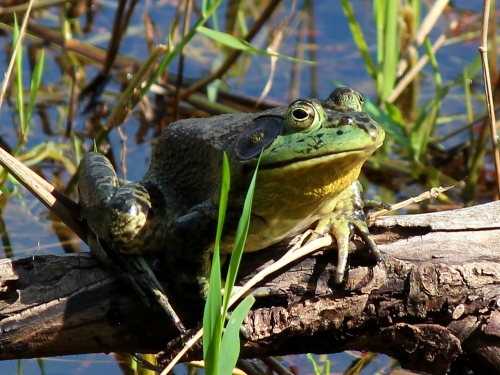 Bullfrog at Rowing Club. Photo by Milt Vine |
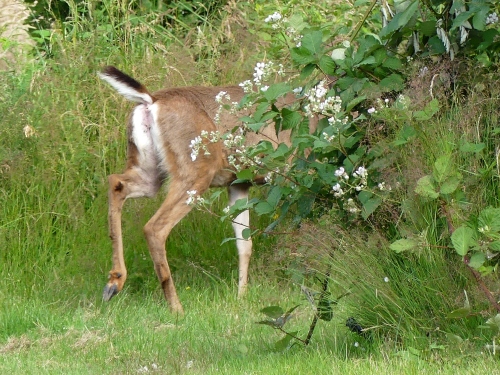 Mule Deer at Rowing Club. Photo by Hugh Jennings |
Report for June 30, 2016 Birding at Marymoor
| A typical pre-4th-of-July day; overcast, temps. near 60. Not exactly warm and sunny, but pleasant enough. The bird list was fairly typical, with only a few surprises. Michael was out of town.
Highlights: Wood Duck 5 - 2 across slough, 3 on our side - juv & female, no male Pied-billed Grebe 2 Green Heron 2 (1 adult) Spotted Sandpiper 1 Mourning Dove 1 Barn Owl 1 at windmill, 1 at meadow Western Screech-Owl 1 (on path) Black Swift probably 2 Willow Flycatcher calling at least 10, they were calling from everywhere Pacific-slope Flycatcher 1, calling and singing, for a while Purple Martin 3 males, 2 females, calling Barn Swallow 15, calling, including young Common Yellowthroat 10 males, singing, 20 females, 30?? Juveniles Black-headed Grosbeak at least 15+ males, singing, M,F & I think young Lazuli Bunting 1 males singing (great looks early near viewing mound) Brewers’ Blackbird 1 juvenile, First of Year For the day, 64 species. Brian Bell |
|
|
|
|
|
|
|
|
|
|
|
|
|
|
|
|
|
|
|
Report for June 25, 2015 Birding at Marymoor
| It was about as summery a day as we ever get, today. Gorgeous clear skies, rather warm, no wind, lots of birds. Not really a lot of bird species, but juveniles have definitely increased the total bird population.
Highlights: Cooper’s Hawk Three sightings; maybe all the same bird Week 26 (which starts today) has the dubious distinction of having the least number of total species recorded over the last 20 years – just 90. (Compare with Week 18 at the beginning of May, at 139 species). Today, we saw over 2/3s of those 90 species. We had 62. == Michael Hobbs |
|
|
|
|
|
|
|
|
|
|
|
|
|
|
|
|
|
|
|
Report for June 26, 2014 Birding at Marymoor
| It was overcast, with light precipitation about 1/3 of the time. Since it was fairly warm (60 degrees) and since the rain only rarely reached “rain”, and stayed mostly at “drizzle” or “mizzle”, things weren’t too bad. It was BIRDY, especially with all of the juvenile birds about. Lots of different, unfamiliar, vocalizations and strange looking birds. It’s been a productive year at the park.
The oddest highlight was a NEW BIRD FOR THE PARK, though not one that we can count. As we neared the Lake Platform, I saw a flash of yellow and green streak past, and noticed a long tail. We were able to find the bird later when it was being chased by an American Robin. It then landed in a willow across the slough, where we could squint at it for quite a while. BUDGERIGAR (i.e. someone’s lost pet Budgie). It had a lemon-yellow head, and it was florescent green over most of the rest of the body. The wings were finely striped in black. I couldn’t tell the color of the tail streamer – either blue or green. It did not seem to have obvious black barring on the nape, but it might just have been hard to see, or the bird might be one of those domesticated forms whose colors differ from the native birds. Definitely not native around here, as Budgies are from Australia. This one must have been blown off course (Yeah, right). Highlights: Wood Duck Very large number of independent juveniles Song Sparrows and Common Yellowthroats feeding juvenile cowbirds; for both host species, we saw multiple cowbird chicks with a single host parent at least once. We also had a MINK cross the path at the Rowing Club. For the day, 61 species plus the Budgie. Nothing new for the year (except the Budgie), so we’re still at 139 for 2014. == Michael Hobbs |
|
|
|
|
|
|
Not all of the baby Great Blue Herons have survived. We found this carcass a couple of hundred yards from the heronry. It may have been an eagle kill; the head, wings, and legs were intact, but the rest of the body had been eaten. I won't show the gory details, but I found the wings interesting. The primary and secondary feathers (the flight feathers) are still present. The blue shafts are the sheathes which the feathers grow inside. As the feather gets more mature, the sheath shortens (peals away, I believe) until the whole feather is revealed. This young bird still needed quite a bit of time on the nest for those feathers to mature. The Marymoor heronry has been very productive this year. I don't know that anyone has done a census, but I believe young were raised on at least 15 nests. Many of the nests have had 3 young on them, which might mean 40+ babies this year. Most seem to have survived to fledging, though obviously not all. Up and down the slough, you can now find juvenile herons attempting to fish. They have a lot to learn. Last week, we saw a juvenile in water that was too deep. Wading too deep not only makes the sight lines worse for spotting fish, it also means that the stabbing thrust to try and catch a fish is accompanied by sloshing a lot of water with the body. That must make success more difficult. Another young bird had the opposite problem; it was standing on a branch too far above the water to reach, though it was staring intently downwards at the prey. Two weeks ago, we saw a juvenile take flight from a branch, only it forgot to let go of the branch... |
|
|
|
|
|
|
Report for June 27, 2013 Birding at Marymoor
|
It was overcast and rather drizzly this morning, but not too unpleasant really. The most notable bird sightings were the numerous juveniles, many being fed by their parents. Highlights: Great Blue Heron Several fledged young along slough edge For the day, 58 species. == Michael Hobbs |
|
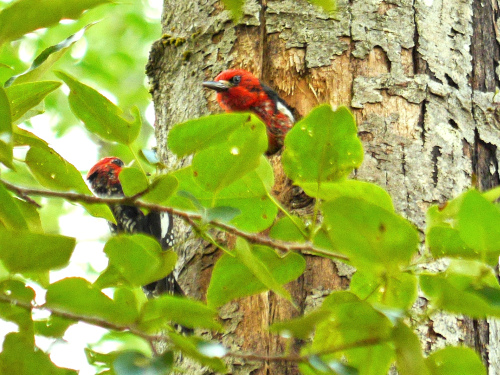 Red-breasted Sapsuckers exchange at the nest, 2013-06-24. Photo by Ollie Oliver |
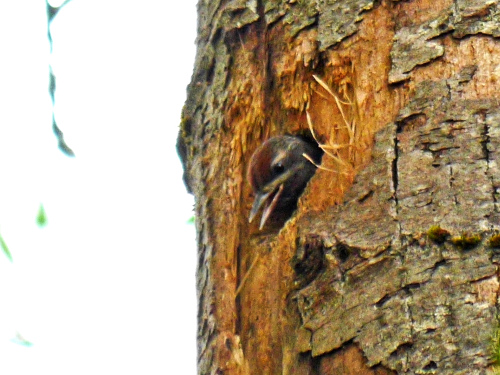 Red-breasted Sapsucker juvenile at the nest, 2013-06-24. Photo by Ollie Oliver |
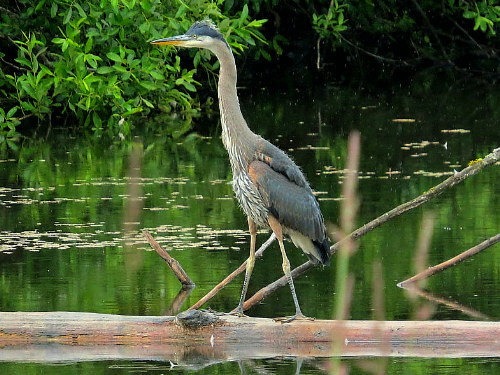 Juvenile Great Blue Heron, 2013-06-23. Photo by Mike Hamilton |
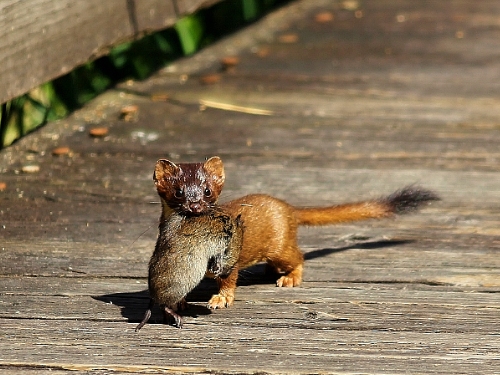 Long-tailed Weasel, 2013-06-22. Photo by Lillian Reis |
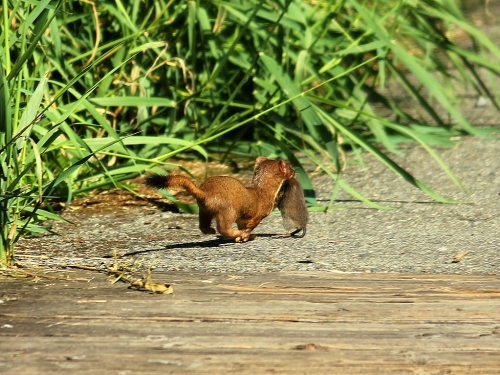 Long-tailed Weasel, 2013-06-22. Photo by Lillian Reis |
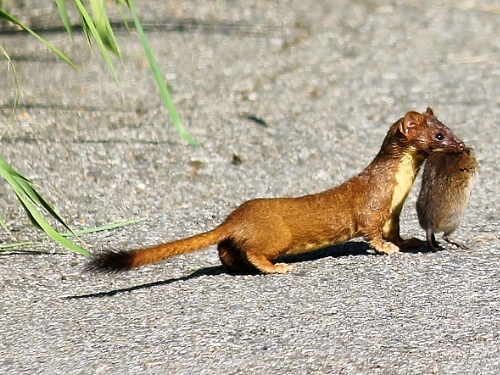 Long-tailed Weasel, 2013-06-22. Photo by Lillian Reis |
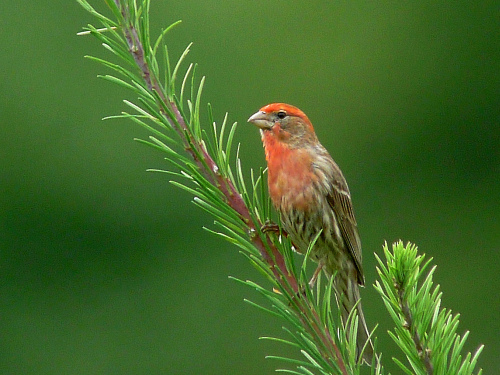 Male House Finch, 2013-06-21. Photo by Ollie Oliver |
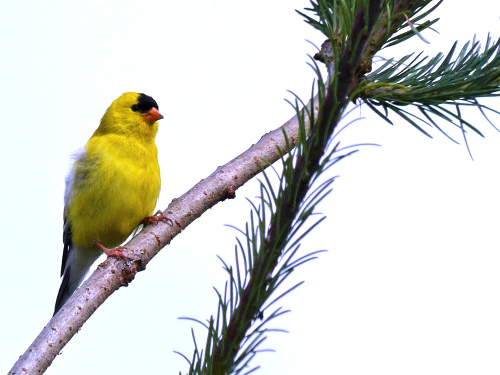 Male American Goldfinch, 2013-06-21. Photo by Ollie Oliver |
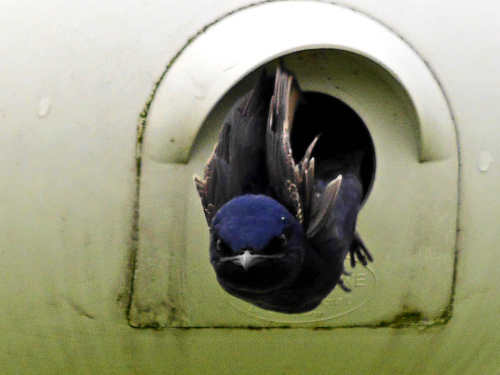 Male Purple Martin bursts from the nest gourd, 2013-06-21. Photo by Ollie Oliver |
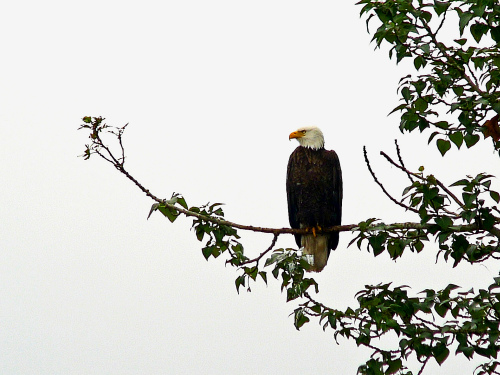 Adult Bald Eagle, 2013-06-21. Photo by Ollie Oliver |
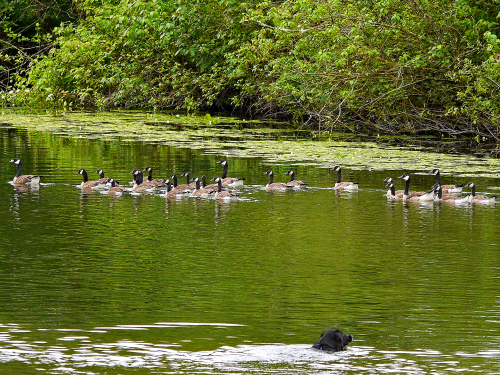 Canada Geese, including young, 2013-06-21. Photo by Ollie Oliver |
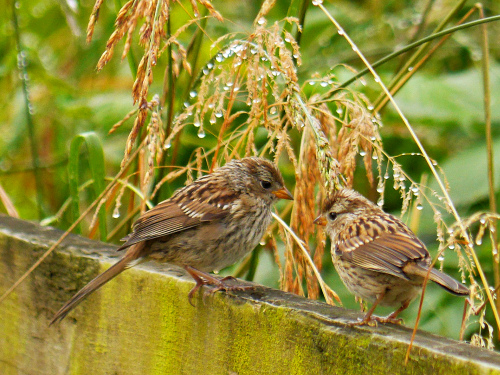 Juvenile White-crowned Sparrows, 2013-06-21. Photo by Ollie Oliver |
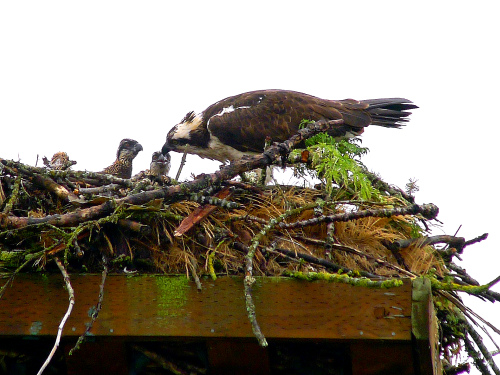 Osprey feeding 3 young at nest, 2013-06-21. Photo by Ollie Oliver |
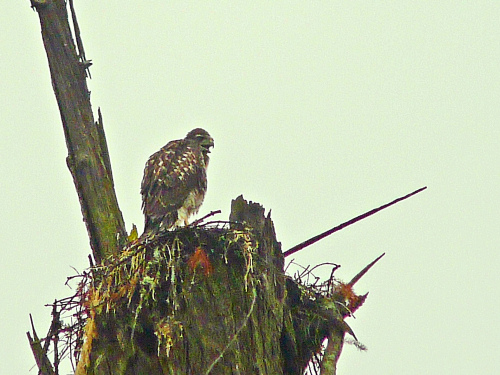 Juvenile Red-tailed Hawk revisits the nest, 2013-06-21. Photo by Ollie Oliver |
Report for June 28, 2012 Birding at Marymoor
|
Michael is in Prague and Matt is back in Minnesota so I got to lead the group out at Marymoor this morning. We had a great day with good weather, cool early then warming up, clear early and some high cirrus later.
Lots of singing today, and lots of young birds around - plenty of practice in recognizing those unusual looking juvenile Dark-eyed Juncos and even some juvenile Yellow-rumped Warblers. The Great Blue Heron young are getting really big and looking like fledging is imminent for many of them - one had fledged and was perched in a snag across from the second dog access point. Terrific bill clacking and complaining from the nest. I had one Barn Owl early over the East Meadow. We wound up seeing and hearing 63 species today. We had so much early activity that it took us from 5:30 to 8:30 to get to Dog Central. Notable species:
Barn Owl East Meadow at 4:13 Green Heron Maybe 2 or 3
Peregrine Falcon Over dog area quickly moving away to the north
Black Swift One bird - very unusual for clear conditions
Cassin's Vireo Singing and excellent views
Purple Martin Male and two females at gourds at lake platform
Western Tanager Heard by Sharon
Brian H. Bell Woodinville Wa
|
|
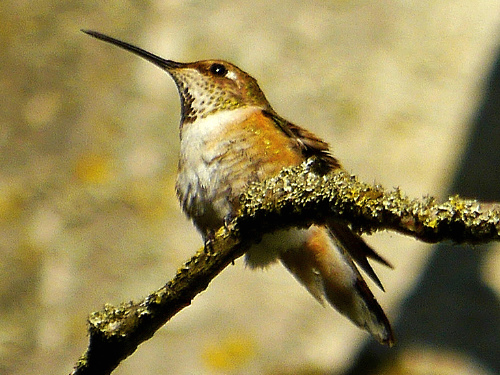 Female or juvenile Rufous Hummingbird. Photo by Ollie Oliver |
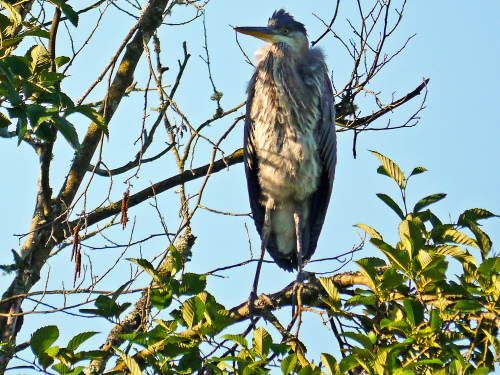 Fledged juvenile Great Blue Heron. Photo by Ollie Oliver |
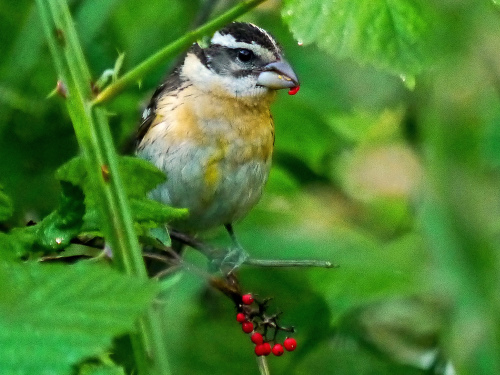 Black-headed Grosbeak. Photo by Ollie Oliver |
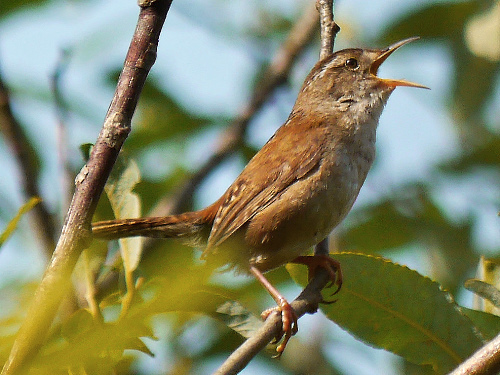 Marsh Wren. Photo by Ollie Oliver |
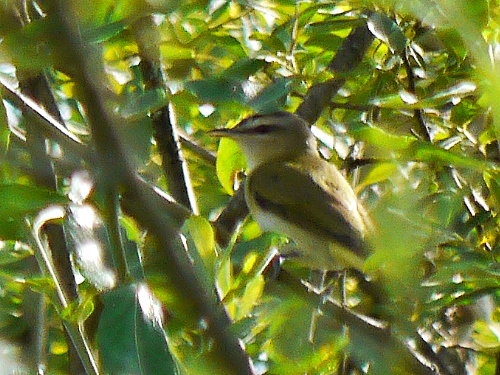 Red-eyed Vireo. Photo by Ollie Oliver |
 Garter Snake. Photo by Ollie Oliver |
Report for June 30, 2011 Birding at Marymoor
|
Except for it being cold enough that we were all wearing sweaters and jackets (and some were wearing gloves) it otherwise felt like a July visit. Quite quiet, nothing too surprising in terms what species we saw, lots of baby birds. But we were still rewarded for our diligence in making the usual rounds. == Michael Hobbs |
|
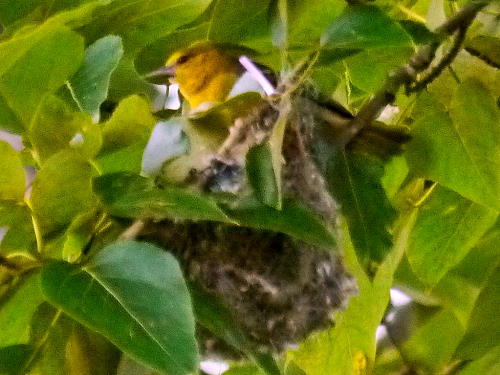 Female Bullock's Oriole at the nest. Photo by Ollie Oliver |
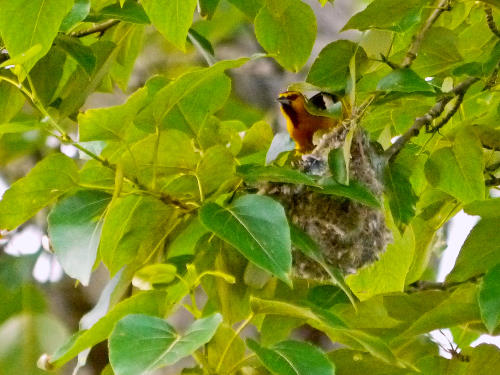 Male Bullock's Oriole at the nest. Photo by Ollie Oliver |
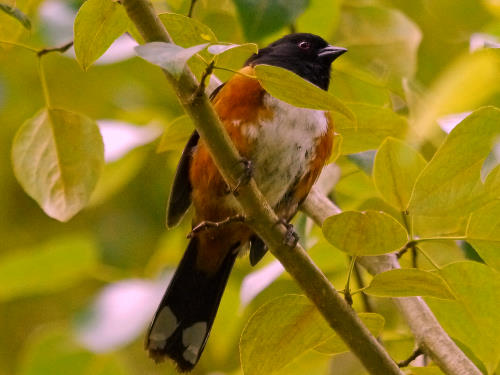 Male Spotted Towhee. Photo by Ollie Oliver |
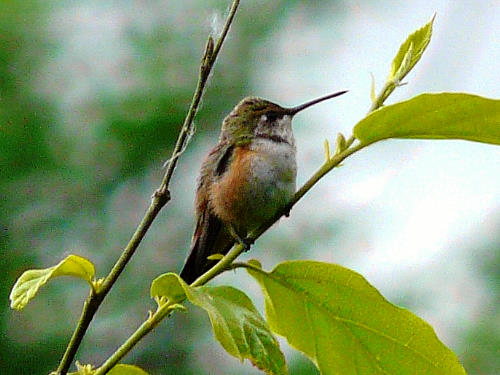 Juvenile Rufous Hummingbird. Photo by Hugh Jennings |
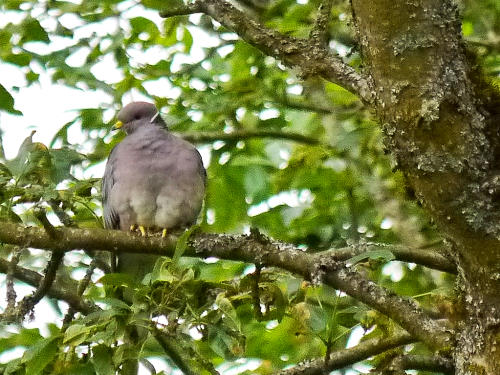 Band-tailed Pigeon. Photo by Ollie Oliver |
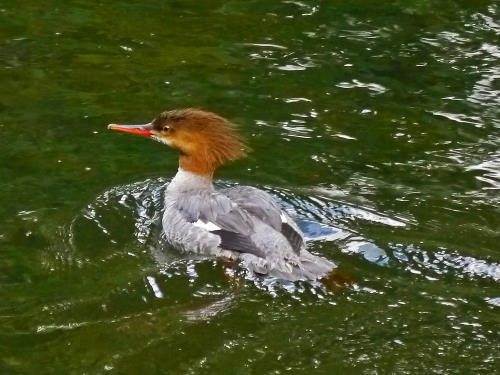 Eclipse male Common Merganser in the slough. Photo by Ollie Oliver |
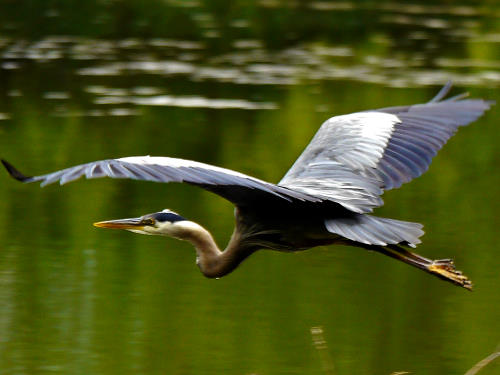 Great Blue Heron. Photo by Ollie Oliver |
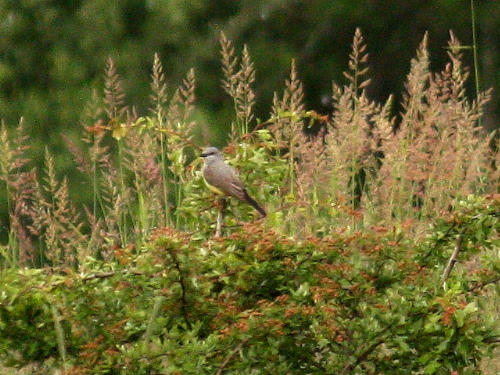 Western Kingbird. Photo by Lillian Reis, 2011-06-24 |
Report for July 1, 2010
|
It was a rather gloomy and damp morning that made me wish I'd worn my gore-tex jacket instead of just a sweatshirt. We had gentle mist most of the morning, which was far less annoying than the mosquitoes. And while a few birds (i.e. robins) were very visible and obvious, things were otherwise pretty quiet. |
|
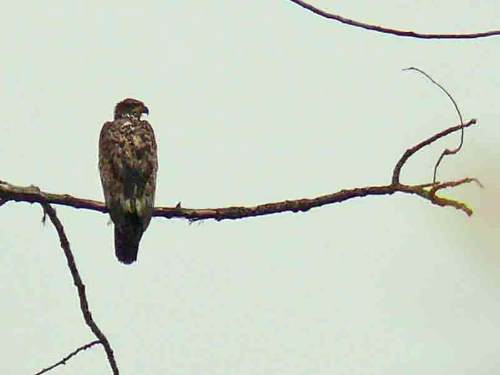 Very pale-backed juvenile Bald Eagle. Photo by Ollie Oliver |
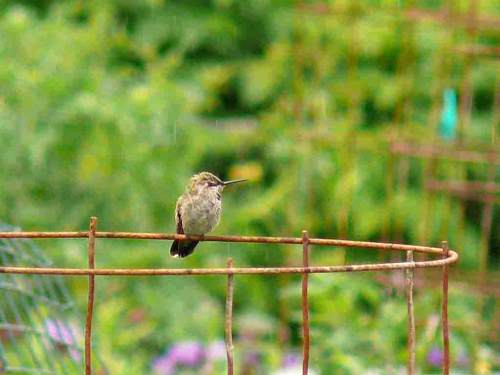 Anna's Hummingbird in the Pea Patch. Photo by Ollie Oliver |
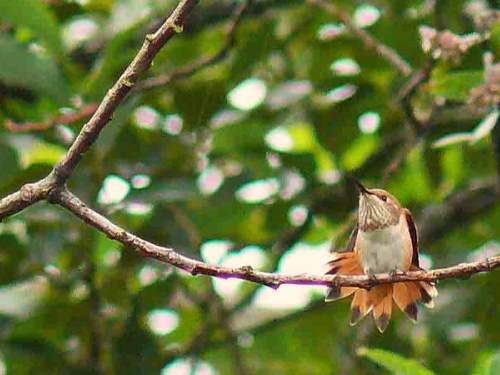 Rufous Hummingbird. Photo by Ollie Oliver |
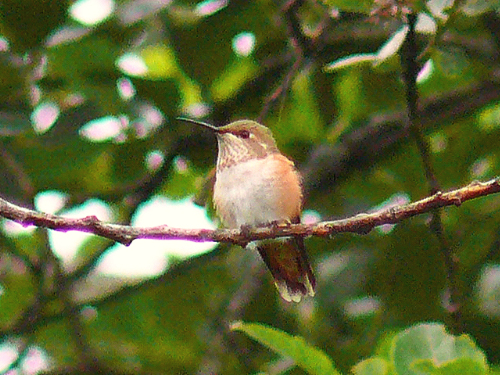 Same bird. Juvenile???. Photo by Ollie Oliver |
Report for June 25, 2009
|
It did not feel like summer today. In absolute terms, the temps were okay (55-64 degrees), but with cloudy skies and a stiff wind, it was chilly. The wind made things difficult as usual. I hate wind. About a dozen of us started out at 5:30 for a pretty decent day. Highlights: AMERICAN BITTERN One seen briefly near the weir The AMERICAN BITTERN was our first for 2009. We get bitterns usually about 3-4 times per year, and we've had them every month except December. They seem to occur slightly more often in May and June than in other months, but with little other discernable pattern. We have not previously had PACIFIC-SLOPE FLYCATCHER often during the peak breeding season; usually only as migrants. One, at least, was singing last Thursday, and was heard again Saturday, and then today. So maybe he's on territory. Last Saturday, my son Tim and I put up two more gourds for PURPLE MARTINS on a piling visible from the lake platform. Today, a female (and later a male) was in the leftmost of the near (old) gourds, and three martins were perched on the crossbar of the new gourd pair. All together, I think we saw 6 martins from the lake platform. On Saturday, Tim and I also canoed over to the northeast corner of the lake, where I was surprised to see that someone had put up some new boxes, and possibly cleaned and refurbished some of the old boxes. In a very quick scan, we found martins in at least 6 of those boxes. So a banner year for nesting Purple Martins at Marymoor! LOT OF BABY BIRDS were about today, including Wood Duck, Hooded Merganser, Osprey (baby(s?) on nest), Bald Eagle, Rufous Hummingbird, Downy Woodpecker, American Crow, Tree Swallow, Black-capped Chickadee, Bushtit, Golden-crowned Kinglet, American Robin, Dark-eyed Junco, and Brown-headed Cowbird. (Maybe some of the House Finch too?) The weasel was very cute! For the day, 54 species. For the year, 141? == Michael |
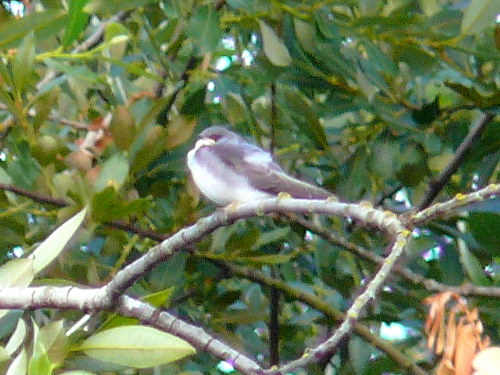 Juvenile Tree Swallow 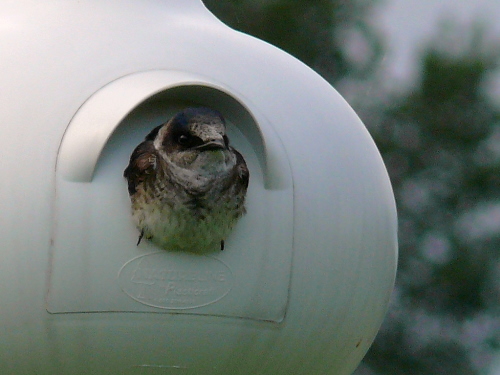 Female Purple Martin |
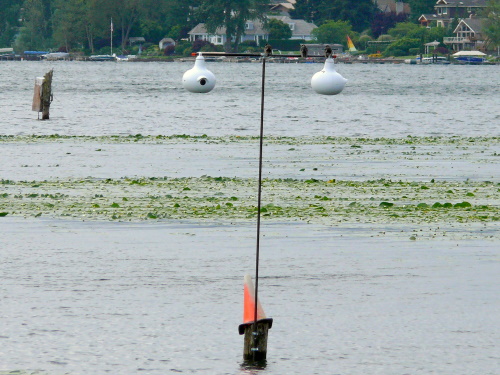 New gourds with 3 Purple Martins visiting |
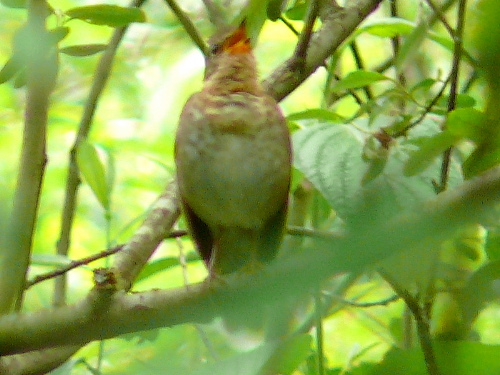 Singing Swainson's Thrush at the Rowing Club |
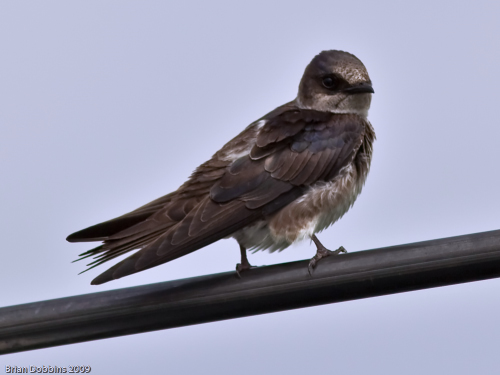 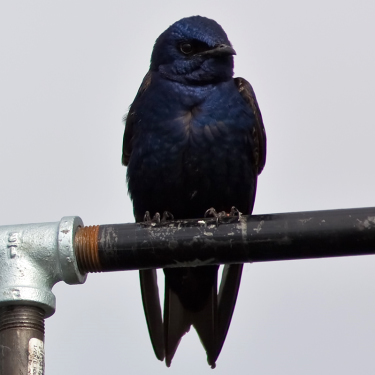 Female (left) and male Purple Martins. Photos by Brian Dobbins, June 26. |
|
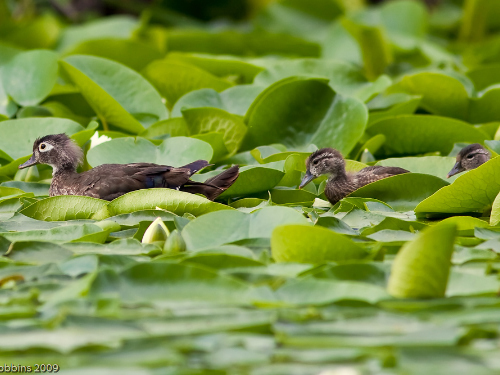 Female Wood Duck with Ducklings. Photo by Brian Dobbins, June 26 |
|
Report for June 26, 2008
|
Another cold, cloudy, breezy, morning. I was hoping for weather like yesterday's, but we got more Junuary. Everybody was wearing sweaters AND coats, and there was a lot of wishing for gloves and talk of hot chocolate. = Michael |
|
|
|
|
|
|
|
|
|
|
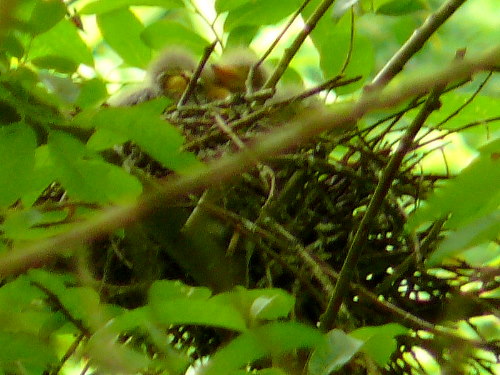 Four babies were seen in the nest (three beaks visible in this photo) |
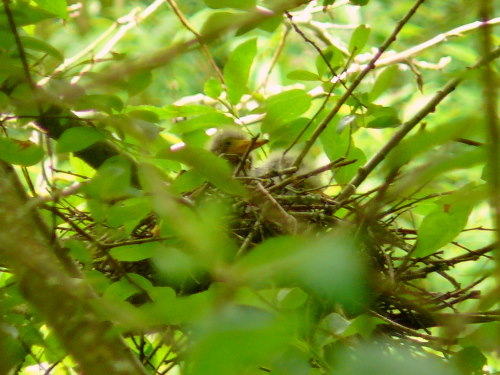 At this age the young look like fluffballs with huge beaks |
Report for June 28, 2007
| I think there were just 10 of us today, under solid, high overcast, with occasional drizzle (but nothing really to speak of). Windless and mosquitoey, temps warming. Quite a nice day today, except that none of us could wake up. I certainly needed a nap when I got back (hence this tardy post).
The species count was pretty good, but there weren't any real surprises. What there was were many opportunities to spend a lot of time watching our common, extraordinary birds. Here are some random highlights: Just before 5:30 a.m., Brian and I saw a SPOTTED SANDPIPER in the containment pond near the paved Event Pad. On a small, dead-topped elderberry in the Dog Meadow were a male AMERICAN GOLDFINCH, a male BLACK-HEADED GROSBEAK, and a male COMMON YELLOWTHROAT. A GREAT BLUE HERON spent more than 10 minutes (at which point I dragged the group off to continue our walk) trying to eat an absolutely enormous fish - maybe a bullhead. The fish must have been a foot long, and looked clearly too big around for a heron to swallow. BLACK-CAPPED CHICKADEES were seen bringing food to, and taking a fecal sac away from a nest hole in one of the easternmost trees in Snag Row. Baby BROWN-HEADED COWBIRDS were seen being fed by a male COMMON YELLOWTHROAT and a SONG SPARROW. A female COMMON MERGANSER sat atop some of the chopped snags in Snag Row, which is comical to see. I had one BLACK SWIFT that challenged my identification skills as it was flying in a straight line flapping continuously. There were an abundance of both RUFOUS and ANNA'S HUMMINGBIRDS, often with intra- and inter-species chases. While we saw them in several places, the highest concentrations were at the south end of the Dog Meadow and in the Pea Patch. We had a juvenile PURPLE FINCH, which is the first I ever remember at Marymoor. Previously, summer sightings of PUFI have been pretty sparse - this year, we've seen them each week. Several other PUFI were singing. At the Rowing Club, I found a WARBLING VIREO singing from a nest. Viewing was VERY OBSCURED, though most of the group (amazingly) managed to see the nest eventually. At the lake, on the new dock, was a single BONAPARTE'S GULL. Brandon found our first RED-BREASTED NUTHATCH since January, in some Doug Firs east of the mansion. Babies abounded: American Robin, European Starling, Dark-eyed Junco, Black-capped Chickadee, Red-tailed Hawk, Brown-headed Cowbird, Tree Swallow, Violet-green Swallow, Barn Swallow, Mallard, Black-headed Grosbeak, Anna's Hummingbird, Purple Finch, Warbling Vireo, Bushtit, Canada Goose, Wood Duck, House Finch, White-crowned Sparrow, and Downy Woodpecker. Probably other species too, but some of the Song Sparrows, for instance, are getting a bit hard to tell from adults. For the day, 61 species. == Michael |
|
|
|
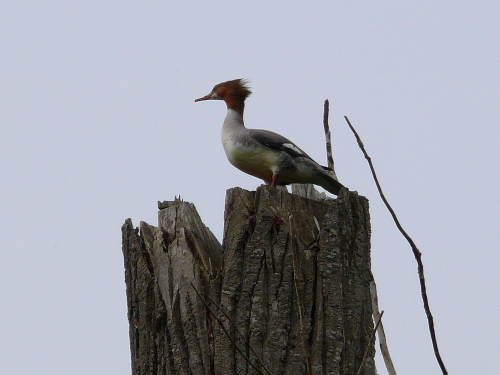 Female Common Merganser on snag |
|
|
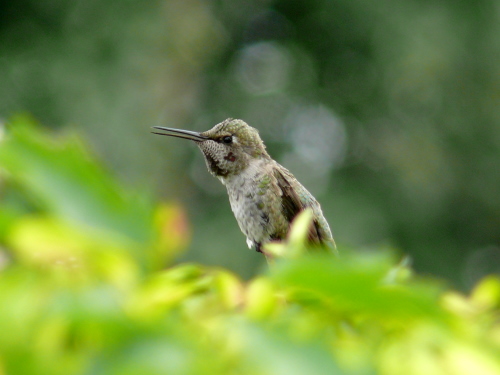 Male Anna's Hummingbird |
|
|
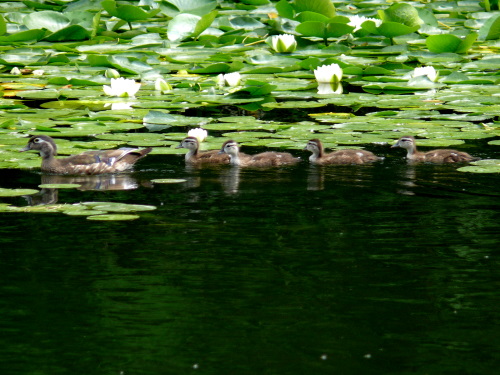 Wood Duck female with babies |
|
|
Peak-a-boo view of a male Yellow Warbler |
Prev |
Bird Sightings Week 26
|
Next |
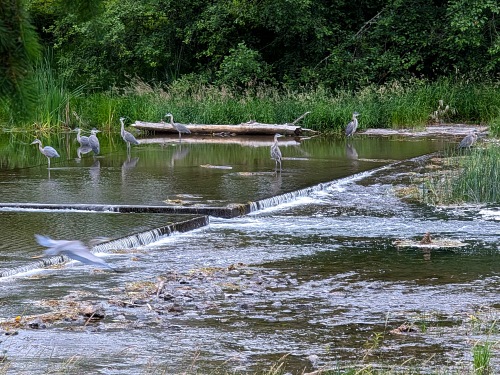





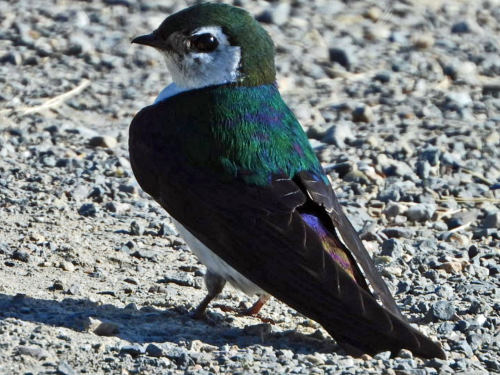
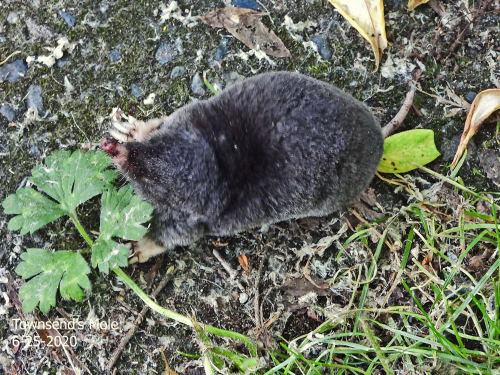
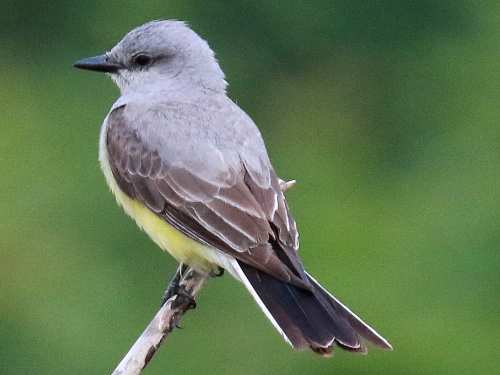
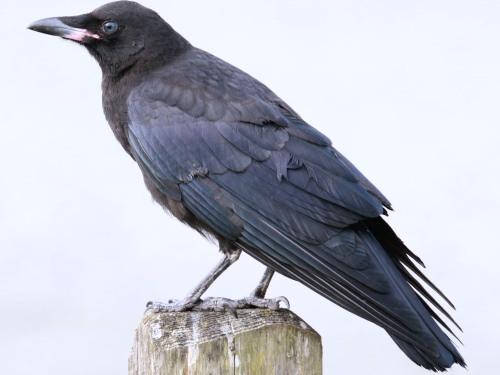
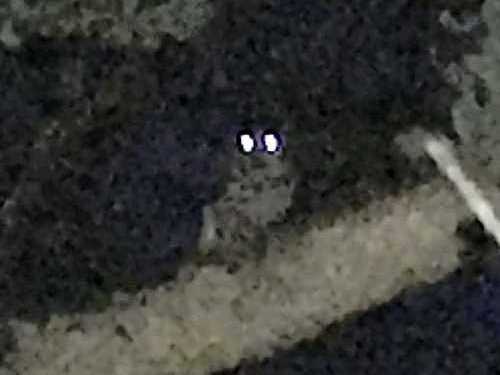

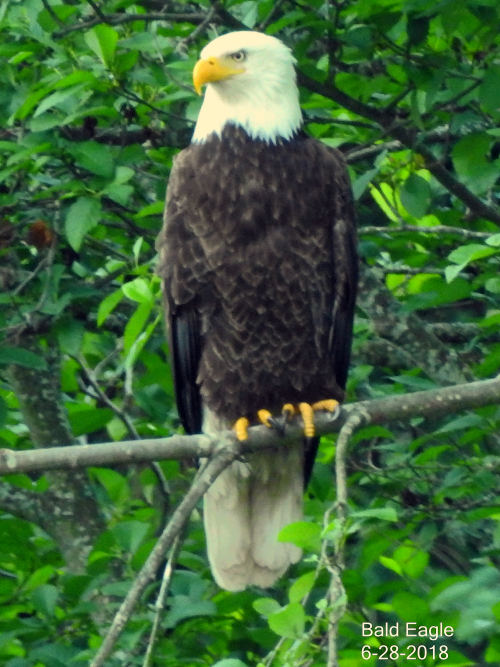
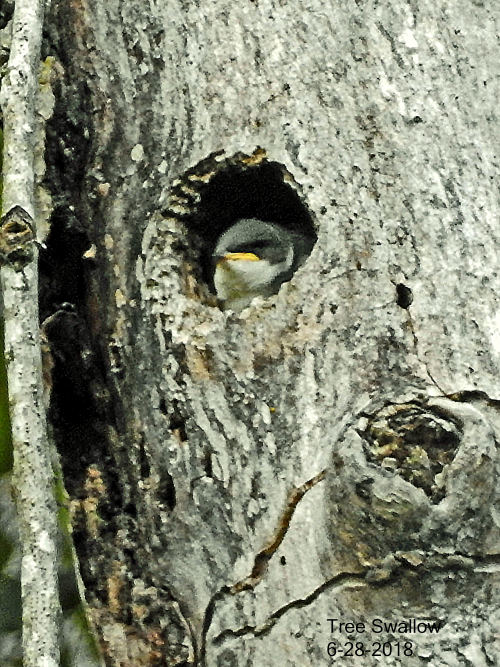
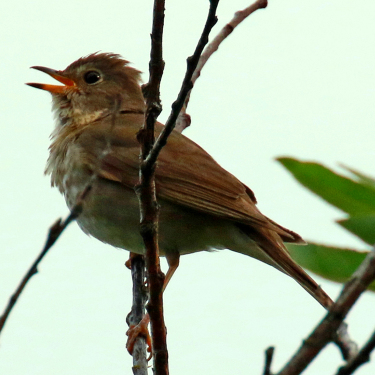
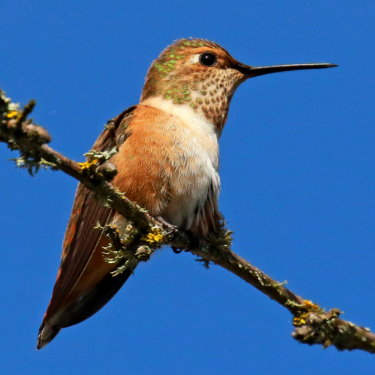
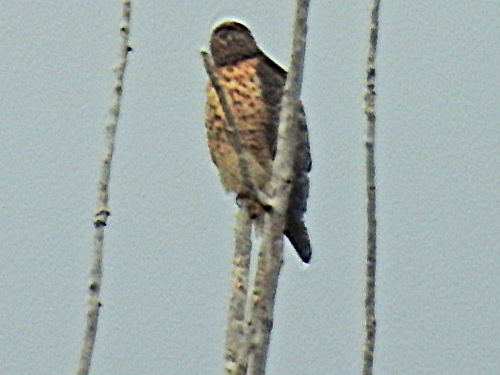
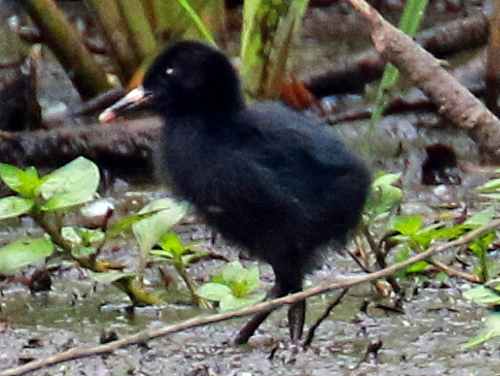
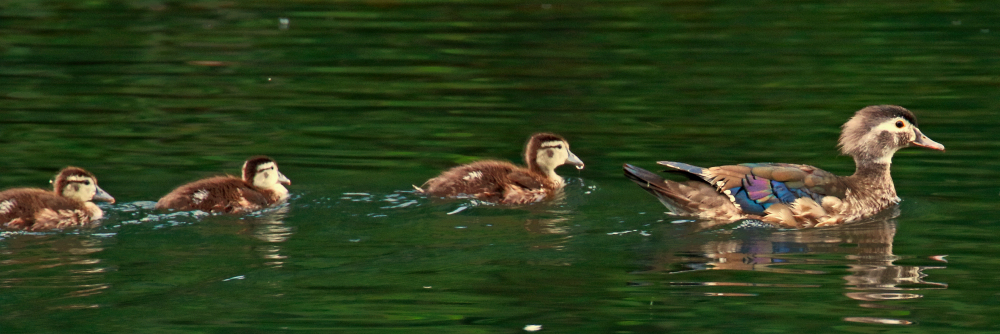

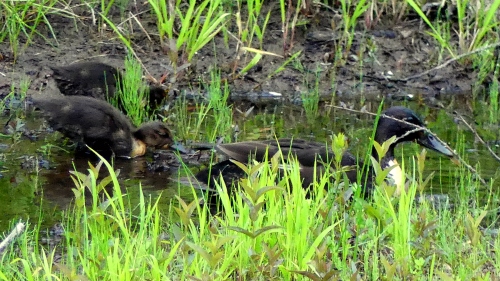
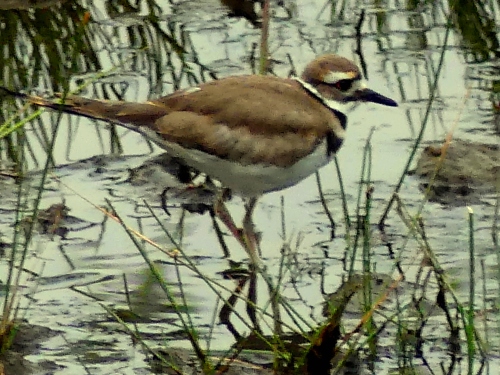
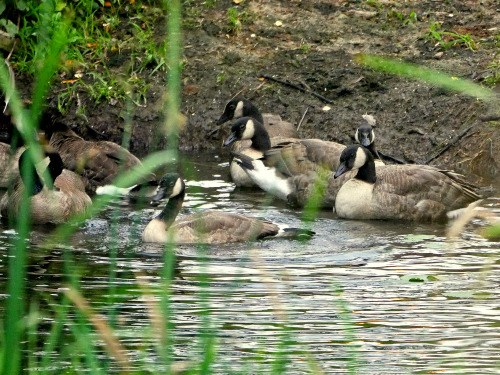
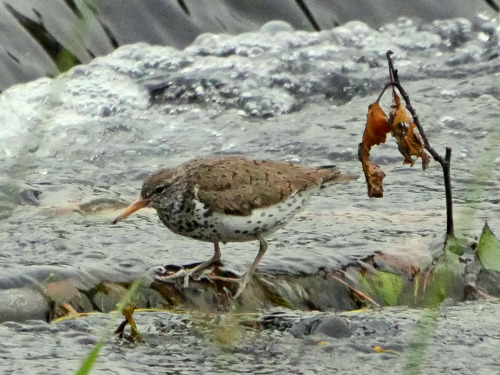
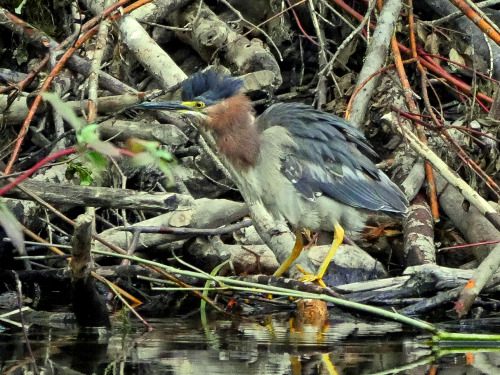
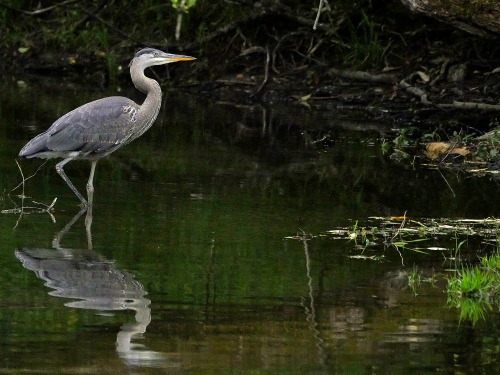
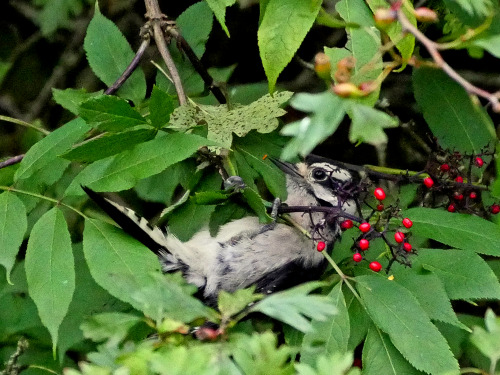
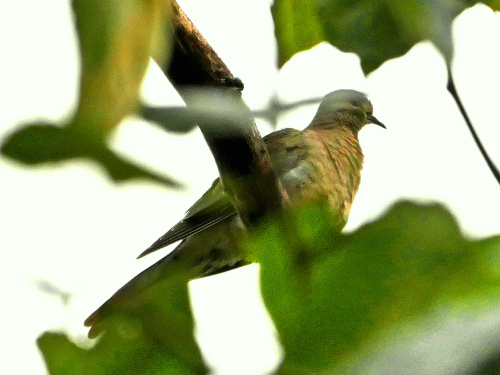
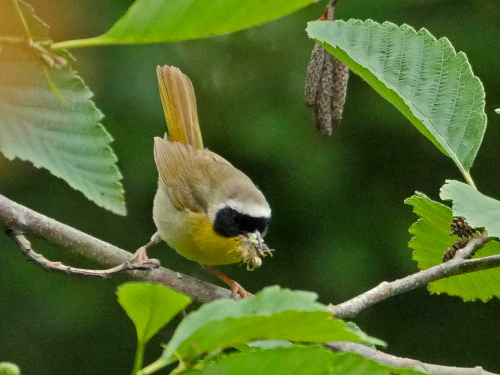
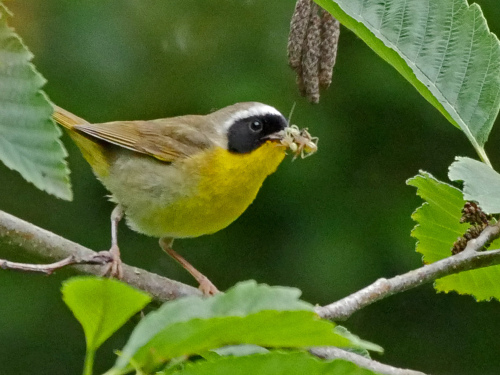
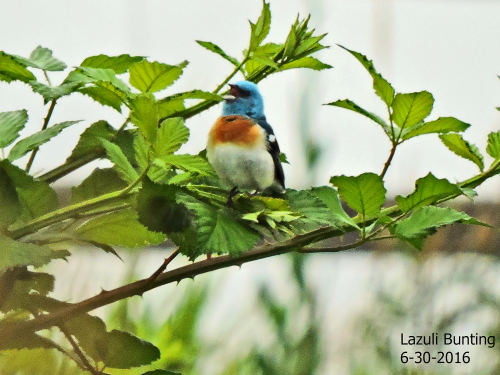
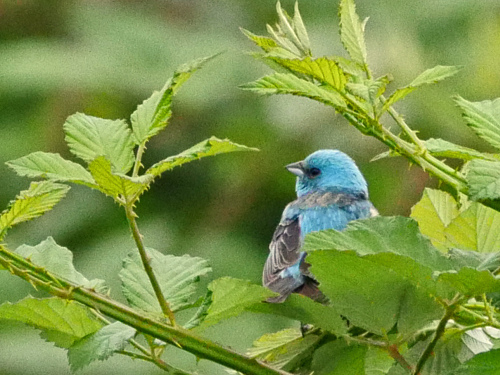
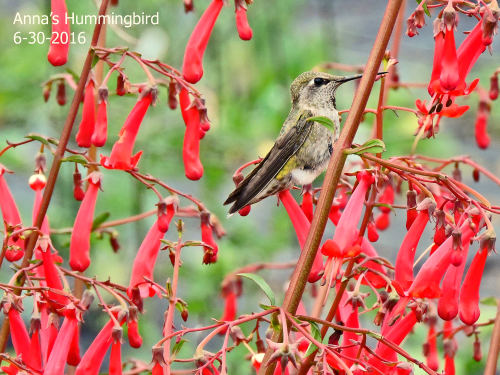
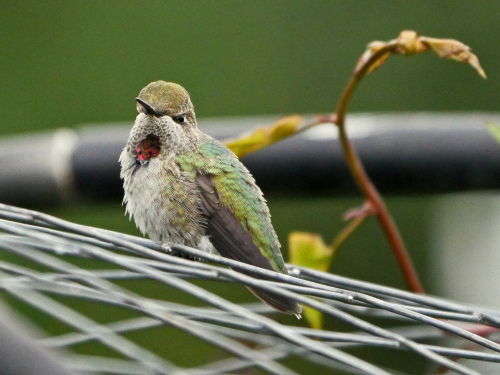
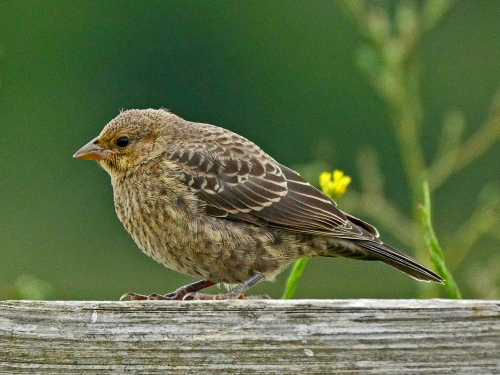
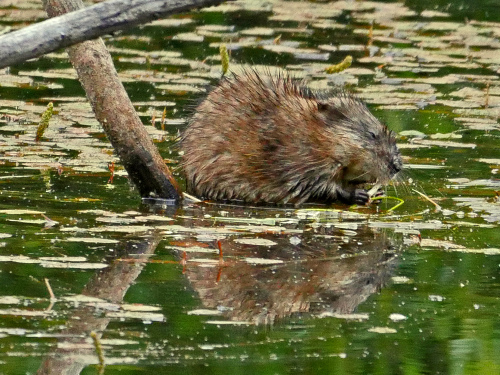
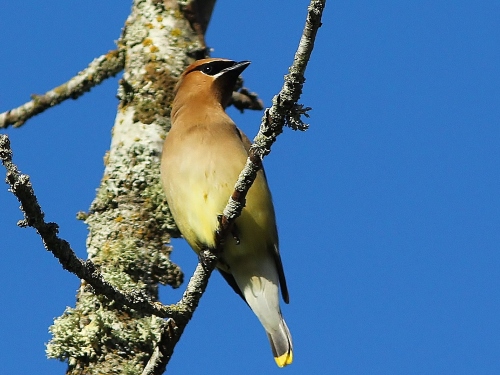
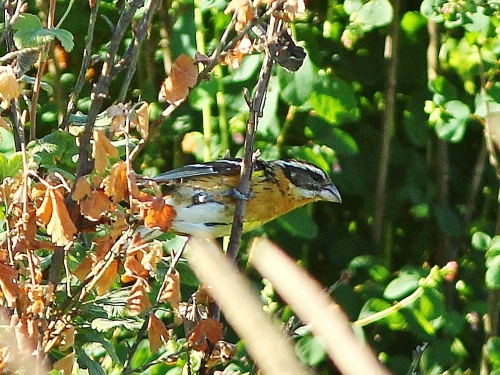
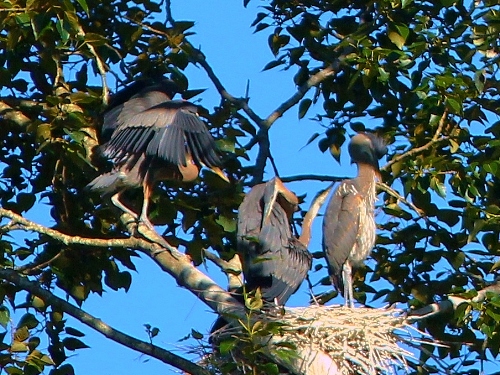
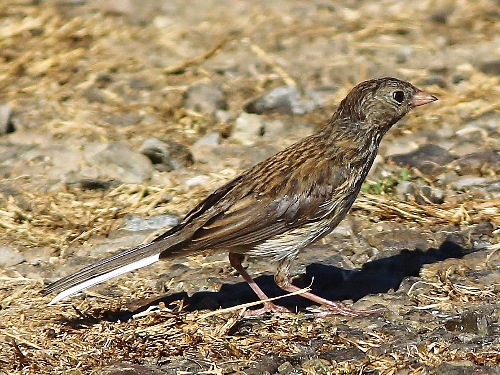
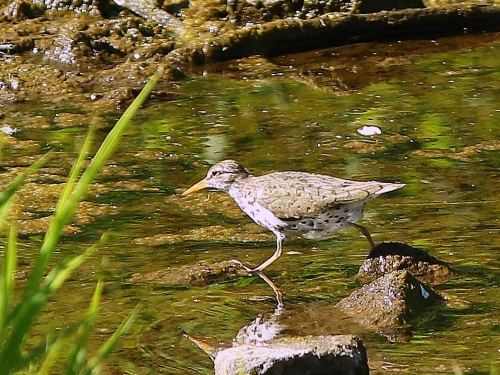
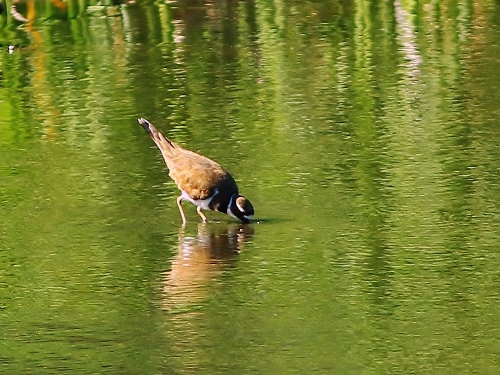
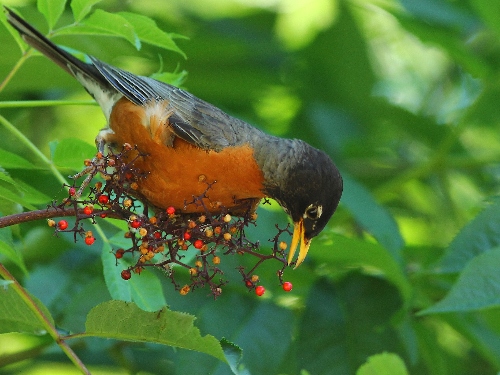 P
P